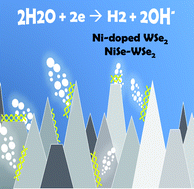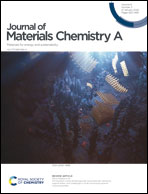Ni–WSe2 nanostructures as efficient catalysts for electrochemical hydrogen evolution reaction (HER) in acidic and alkaline media†
Abstract
Layered transition metal dichalcogenides (TMDCs) are an emerging family of catalysts. Included in this group is tungsten diselenide (WSe2), which has attracted recent attention for electro-optical applications. Tungsten is opportune because it is the heaviest transition metal in the TMDC family and is widely abundant on Earth. Moreover, WS2 and WSe2 are more benign in nature than their molybdenum counterparts. Despite this, WSe2 has been relatively unexplored as a catalyst. We report the synthesis of WSe2 doped with various transition metals (Fe, Co, Nb, Ni and Zr). Among the doped catalysts, Ni–WSe2 has been found to be the most promising electrocatalyst for the hydrogen evolution reaction (HER) as it possesses the smallest charge transfer resistance and thus facilitates a faster catalytic reaction. Upon doping with Ni, catalytic enhancement results from improved hydrogen adsorption (Hads). Beyond this threshold of Ni loading, the improved activity in alkaline medium is due to the optimized interaction of the OH/surface active sites. Using density functional theory calculations, we identified that the catalytic sites are Se atoms either bound to a substitutional Ni dopant or constituting a small patch of NiSe grafted on the WSe2 surface.



 Please wait while we load your content...
Please wait while we load your content...